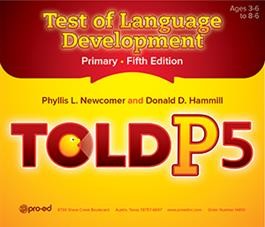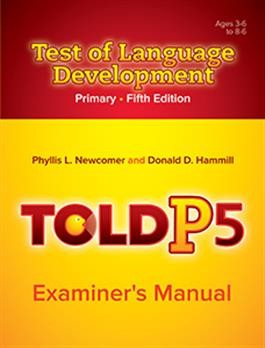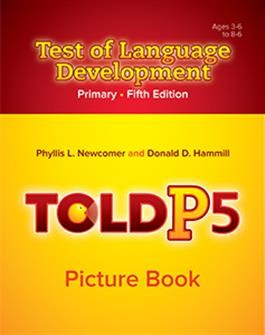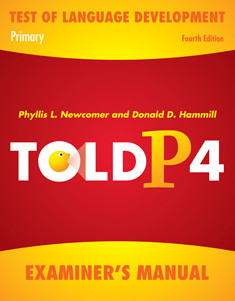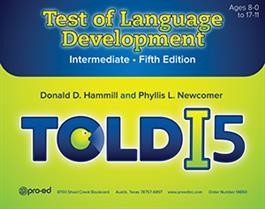Test of Language Development - Primary (TOLD-P:5)
Complete Kit
Fifth Edition
- Ages 4-0 to 8-11 years
- Testing Time 30min.-1hr.
- Administration Individual
-
Product Code 14810 ( MR #067947 )
* Qualifications required to purchase this item. Click here to complete the qualifications form.
Price $481.00
Contents
The TOLD-P:5 assesses spoken language in young children. It is well constructed, reliable, practical, research-based, and theoretically sound. Professionals can use the TOLD-P:5 to (1) identify children who are significantly below their peers in oral language proficiency, (2) determine their specific strengths and weaknesses in oral language skills, (3) document their progress in remedial programs, and (4) measure oral language in research studies.
Subtests and Composites
The TOLD-P:5 has six core subtests and three supplemental subtests which measure various aspects of oral language are described below. The results of these subtests can be combined to form composite scores for the major dimensions of language: semantics and grammar; listening, organizing, and speaking; and overall language ability.
Core Subtests
- Picture Vocabulary - measures a child's understanding of the meaning of spoken English words (semantics, listening)
- Relational Vocabulary - measures a child's understanding and ability to orally express the relationships between two spoken stimulus words (semantics, organizing)
- Oral Vocabulary - measures a child's ability to give oral definitions to common English words that are spoken by the examiner (semantics, speaking)
- Syntactic Understanding - measures a child's ability to comprehend the meaning of sentences (grammar, listening)
- Sentence Imitation - measures a child's ability to imitate English sentences (grammar, organizing)
- Morphological Completion - measures a child's ability to recognize, understand, and use common English morphological forms (grammar, speaking)
Supplemental Subtests
- Word Discrimination - measures a child's ability to recognize the differences in significant speech sounds (phonology, listening)
- Word Analysis - measures a child's ability to segment words into smaller phonemic units (phonology, organizing)
- Word Articulation - measures a child's ability to utter important English speech sounds (phonology, speaking)
Normative Scores
The TOLD-P:5 Online Scoring and Report System (provided as part of the TOLD-P:5 Complete Kit) was designed as a quick, efficient tool for (a) entering test session data; (b) converting subtest item scores or subtest total raw scores into scaled scores; (c) converting sums of scaled scores into composite index scores, percentile ranks, and upper and lower confidence intervals; (d) comparing TOLD-P:5 scores to identify significant intraindividual differences; and (e) obtaining a score summary and narrative report.
The TOLD-P:5 Online Scoring and Report System yields four types of normative scores: age equivalents, percentile ranks, subtest scaled scores, and composite indexes. Percentiles provide the examiner with an index that is easily understood by parents and others with whom the test results are to be shared. Subtest scaled scores are based on a distribution having a mean of 10 and standard deviation of 3. Composite indexes are based on a distribution having a mean of 100 and standard deviation of 15. Age equivalents are indexes of relative standing that translate subtest raw scores to what are commonly termed language ages.
New Features of the TOLD:P-5
- All new normative data (N = 1,007) stratified by age to conform to those of the projected U.S. school-age population for the year 2015 reported in ProQuest Statistical Abstract of the United States 2017, and are thereby representative of the U.S. population.
- New studies of the floors, ceilings, and item gradients for the TOLD-P:5’s subtests and composites were conducted. The results indicated that the test has consistently excellent ability across all ages and ability levels to not only measure students’ spoken language ability but also detect minor fluctuations in those abilities.
- New studies of test bias (both differential item functioning and subgroup comparison studies) were conducted that indicated that the test possesses little or no bias in regard to gender, race, or ethnicity.
- New extensive criterion-prediction validity studies were conducted to demonstrate the validity of the TOLD-P:5’s subtests and composites, including diagnostic accuracy analyses. Diagnostic accuracy analyses are particularly rigorous techniques for establishing validity, involving the computation of a test’s sensitivity index, specificity index, and ROC/AUC. These studies indicated that the test is a highly valid measure of spoken language ability.
- New extensive studies of construct-identification validity, including studies of age differences, subgroup performance, relationship to achievement, and confirmatory factor analysis of the text’s structure, were conducted. These studies indicated that the test’s internal structure is sound and its results are valid for a wide variety of subgroups, as well as for a general population.
- All new Online Scoring and Report System is now included and provides and efficient and easy way to obtain TOLD-P:5 scores and corresponding narrative.
- Copyright 2019

 Proud to be Canadian
Proud to be Canadian